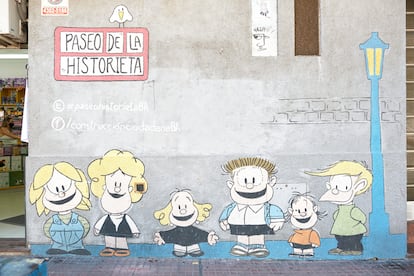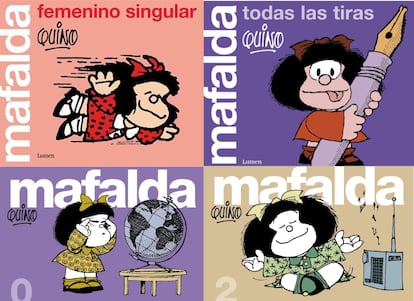“Stop the world, I want to get off!” Mafalda shouts, drawn next to a globe. The cartoon was and is widely disseminated, but it is apocryphal: not so much because Joaquín Lavado, Quino, never drew it, but because Mafalda never stopped and continues to tour with the world. Although the character had had some previous, isolated appearances, the first strip appeared on September 29, 1964 and today, 60 years later, Mafalda, that “angry heroine who rejects the world as it is” (as she defined her, early, Umberto Eco), that tender and rebellious girl who still represents Argentina’s dwindling middle class, continues to be read, laughed at and published. Bridging languages and borders, it is revisited and recreated in different formats (last year a documentary was released, next year promises an animated series), it stars in shows and exhibitions, it continues to seduce new generations.
“Mafalda always sells,” they respond today in any bookstore in Buenos Aires, where it all began in the sixties. Quino (1932-2020) had arrived from Mendoza and, already with a decade of experience in graphic humor, in 1962 he had been invited to create a strip to advertise the Mansfield brand of household appliances, from the company Siam Di Tella. The project did not prosper, but the strip did. Two years later his success would begin in magazines and newspapers, until in 1973, in a convulsed country that was unknowingly marching towards the terrorism of the military dictatorship (1976-1983), the author decided to stop drawing his characters.
Since then, Mafalda, the girl who hates soup and loves the Beatles, lives, above all, in the books that compile her strips. “Mafalda’s popularity continues to be notable internationally,” says Jorgelina Burgos, assistant at Ediciones de la Flor, the publishing house that has published it for 55 years. “The Argentine public,” he adds, “remains constant over time, which indicates that readers continue to be renewed. We notice this year after year at fairs.”
Why does its appeal endure? Its creator did not know: “I don’t understand the validity of Mafalda. The world is changing a lot and people continue reading things that one drew so long ago, that it seems that nothing has changed,” commented Quino in 2014, when he received the Prince of Asturias Award for Communication and Humanities. But in many aspects of the strip it is possible to find the reasons for its validity.
The humor
“Quino’s humor is a conceptual humor that has a long-lasting component because it addresses issues that define the human condition, such as inequality, injustice, friendship, jealousy, good and evil,” explains Uruguayan historian Isabella Cosse, author of Mafalda: social and political history (FCE). He also highlights that “Quino worked on identity, one laughs when seeing a scene or a stereotype because it refers to something of one’s own.” Beyond the attributes of the work, humor itself demands a more active role from the public than other cultural productions. “Quino said that, for a strip to be successful, the last frame had to be completed by the reader. This characteristic of humor allows for a constant updating and resemantization of each Mafalda comic.”
The characters
“The great richness of the strip is linked to the psychological archetypes that Quino proposed, which are universal and today continue to tell us something: Mafalda, Susanita, Manolito, Felipe, Miguelito… We recognize ourselves in those characters, perhaps not in a specific one. , but one day we are in the Susanita role, another day in the Manolito role,” says the Argentine writer and screenwriter Pablo De Santis.
In one of the first critical texts that analyzed Quino’s work, the semiologist Oscar Steimberg defined the main characters like this in 1971: “Mafalda is an up-to-date humanist, Manolito a mercantilist, Susanita a hypocritical lady, Felipito a citizen with sense. common, Miguelito, a fascist intellectual who little by little is transforming, terribly, into a professional of methodical doubt.” In addition to Mafalda’s parents, the mischievous little brother, Guille, was missing from the list. Also Libertad, the last character to join: “With Libertad enter the political demands of the seventies. Libertad is a kind of another Mafalda, but more radicalized,” says De Santis.
“Quino relied a lot on Peanuts (Charles Schulz’s strip, starring Charlie Brown and Snoopy) and added the world of adults, which was completely absent in the North American strip.” In contrast to that adult world, mocked and challenged, the figure of Mafalda emerged. Perhaps there lies the seduction that the strip exerts on children, despite the fact that Quino always thought of an adult audience.

The themes
A key factor in the strip’s permanence comes from the major themes present in its vignettes. “In the sixties, Quino talked about emerging phenomena. When he decides that the central character is a rebellious girl, he is operating with very new phenomena such as feminism, generational confrontations, the emergence of young people—especially young women—as subjects of a social upheaval. Working on these phenomena gave life to his humorous constructions,” explains Cosse.
Professor emeritus at the University of Buenos Aires, Steimberg observes that “one of Mafalda’s central features was her relationship with new ways of understanding the effects of communication. It was as if Mafalda renewed the possibility of knowing what was done in each social, economic and political place.” For the semiologist, “Quino’s work includes a kind of self-criticism, as if he had said: recognize that in every home, in every family formation, in every workplace, there will be possibilities and difficulties of communication. There will not be a space where those learning needs disappear or can be replaced or canceled. That is where he raises again, at every step, the need to share knowledge, practices and experiences.”
The recreations
“Journalists, editors, translators and the readers of the comic themselves have played a central role so that Mafalda circulated and acquired new meanings in each place and each time,” says Cosse, a researcher at Conicet and the National University of San Martín (Unsam). . Along with the different compilations of the strip in book format, with translations into more than 30 languages, short and feature-length animated films have also been produced over the years. Last year the documentary was released Rereading Mafalda and an animated series directed by Juan José Campanella is planned for 2025. “Now some strips officially appear on Instagram and other social networks,” says Cosse, who also highlights the numerous exhibitions and urban interventions linked to the strip and its characters.

The silence
Paradoxically, the end of Mafalda in 1973 cemented its future. The cartoonist always admitted that he abandoned the strip to avoid repeating himself. “Quino had the ability to cut the comic when there was no longer so much room for humor, because everything was turning bloody in the country. It must have been a difficult artistic decision, but in large part that made the comic last,” says De Santis, author of The Ride of the Valkyries (Planet).
Cosse highlights the same: “When Quino stopped making Mafalda, the comic was no longer in the middle of the fierce dispute that was taking place in Argentine society in the 1970s. Mafalda was being discussed by the right and the left, for some she was bourgeois and for others, a dangerous subversive. In some way, that decision prevented Mafalda from having to speak out further and allowed what she had already said to be redefined over time.”
The identity
After the fall of the Berlin Wall, the rise of neoliberalism was a shock for the progressive middle classes. Cosse maintains that then, in the nineties, “Mafalda became, for many in Argentina, a mythical place that symbolized the ideas and elements of an identity that was being strongly confronted and beaten. A nostalgic reading of Mafalda is developed as a place of origin where a we to reinvent is recognized.”
The 60th anniversary of Mafalda coincides with a moment of global revitalization of right-wing discourses, with Argentina governed by an ultra party. How can Quino’s strip be read today? “Mafalda continues to be an expression of social protest, of the ability to confront power, of humor and irony,” responds Cosse. “The interventions of the new right in the public scene have a virulence, a furious character that installs a very ferocious, very cruel humor. In this context, Mafalda’s humor can perhaps reaffirm an identity with a certain tenderness and the possibility of recognizing, in otherness, an other similar to oneself,” he says. And remember a vignette: Mafalda and Susanita, sitting shoulder to shoulder, with their backs to the reader. “How can we be friends when we can’t stand each other?” they ask themselves, while successively calling each other stupid, moron, carrot, and potato. “Rather than not putting up with a stranger… what do I know, I’d rather not put up with you all my life.”
Subscribe here to the newsletter of THE COUNTRY America and receive all the key information on current events in the region.

